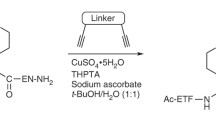Abstract
A `biocompatible' safety-catch linker based on an internal diketopiperazine release has been developed to allow the release of amine based compounds. The synthesis of the linker and its pre-loading with a representative set of amines is described. After immobilization onto an amino Tentagel resin, the linker was activated and the amines were released under biological conditions at pH 8.
Similar content being viewed by others
References
a. Terret, N.K., Gardner, M., Gordon, D.W., Kobylecki, R.J. and Steele, J., Combinatorial synthesis-The design of compound libraries and their application to drug discovery, Tetrahedron, 51 (1995) 8135–8173. b. Gordon, E.M., Gallop, M.A. and Patel, D.V., Strategy and tactics in combinatorial organic synthesis. Applications to drug discovery, Acc. Chem. Res., 29 (1996) 144–154. c. Lam, K.S., Lebl, M. and Krchnák, V., The 'one-bead-onecompound' combinatorial library method, Chem. Rev., 97 (1997) 411–448.
a. Still, W.C., Discovery of sequence-selective peptide binding by synthetic receptors using encoded combinatorial libraries, Acc. Chem. Res., 29 (1996) 155–170. b. Lam, K.S., Salmon, S.E., Hersh, E.M., Hruby, V.J., Kazmierski, W.M. and Knapp, R.J., A new type of synthetic peptide library for identifying ligand-binding activity, Nature (London), 354 (1991) 82–84. c. Meldal, M., Svendsen, I., Breddam, K. and Auzanneau, F.-I., Portion-mixing peptide libraries of quenched fluorogenic substrates for complete subsite mapping of endoprotease specificity, Proc. Natl. Acad. Sci. USA, 91 (1994) 3314–3318. d. Youngquist, R.S., Fuentes, G.R., Lacey, M.P. and Keough, T., Generation and screening of combinatorial peptide libraries designed for rapid sequencing by mass spectroscopy, J. Am. Chem. Soc., 117 (1995) 3900–3906.
a. James, I.W., Linkers for solid phase organic synthesis, Tetrahedron, 55 (1999) 4855–4946. b. Guillier, F., Orain, D. and Bradley, M., Linkers and cleavage strategies in solid-phase organic synthesis and combinatorial chemistry, Chem. Rev., 100 (2000) 2091–2157.
a. Salmon, S.E., Lam, K.S., Lebl, M., Kandola, A., Khattri, P.S., Wade, S., Pátek, M., Kocis, P., Krchnák, V., Thorpe, D. and Felder, S., Discovery of biologically active peptides in random libraries: solution-phase testing after staged orthogonal release from resin beads, Proc. Natl. Acad. Sci. USA, 90 (1993) 11708–11712. b. Kočiš, P., Krchňák, V. and Lebl, M., Symmetrical structure allowing the selective multiple release of a defined quantity of peptide from a single bead of polymeric support, Tetrahedron Lett., 34 (1993) 7251–7252. c. Pátek, M. and Lebl, M., Safety-catch and multiply cleavable linkers in solid phase synthesis, Biopolymers, 47 (1998) 353–363.
a. Fromont, C. and Bradley, M., High-loading resin beads for solid-phase synthesis using triple branching symmetrical dendrimers, Chem. Commun., (2000) 283–284. b. Wells, N.J., Basso, A. and Bradley, M., Solid-phase dendrimer synthesis, Biopolymers, 47 (1998) 231–396. c. Swali, V., Wells, N.J., Langley, G.J. and Bradley, M., Solid-phase dendrimer synthesis and generation of superhigh-loading resin beads for combinatorial chemistry, J. Org. Chem., 62 (1997) 4902–4903.
Bray, A.M., Maeji, N.J., Valerio, R.M, Campbell, R.A. and Geysen, H.M., Direct cleavage of peptides from solid support into aqueous buffer. Application in simultaneous multiple peptide synthesis, J. Org. Chem., 56 (1991) 6659–6666.
Atrash, B. and Bradley, M., A pH cleavable linker for zone diffusion assays and single bead solution screens in combinatorial chemistry, Chem. Commun., (1997) 1397–1398.
Belshaw, P.J., Mzengeza, S. and Lajoie, G.A., Chlorotrimethylsilane mediated formation of !-allylesters of aspartic and glutamic acids, Synth. Commun., 20 (1990) 3157–3160.
Nakatami, M., Nakata, T., Kouge, K. and Okei, H., Studies on bitter peptides from casein hydrolyzate XIV Bitter taste of synthetic analogs of octapeptides, Arg-Gly-Pro-Phe-Pro-Ile-Ile-Val, corresponding to the C-terminal portion of β-casein, Bull. Soc. Chim. Jap., 67 (1994) 438–444.
An, H., Cummins, L.L., Griffey, R.H., Bharadwaj, R., Haly, B.D., Fraser, A.S., Wilson-Lingardo, L., Risen, L.M., Wyatt, J.R. and Cook, P.D., Solution phase combinatorial synthesis. Discovery of novel polyazapyridinophanes with potent antibacterial activity by a solution phase simultaneous addition of functionalities approach, J. Am. Chem. Soc., 119 (1997) 3696–3708.
a. Smith, H.K. and Bradley, M., Comparison of resin and solution screening methodologies in combinatorial chemistry and the identification of a 100 nM inhibitor of trypanothione reductase, J. Comb. Chem., 1 (1999) 326–332. b. Marsh, I.R. and Bradley, M., Solid phase synthesis of polyamine conjugates for the study of trypanothione reductase, Tetrahedron, 53 (1997) 17317–17334.
Author information
Authors and Affiliations
Rights and permissions
About this article
Cite this article
Orain, D., Bradley, M. A safety-catch linker for amine release under biologically compatible conditions. Mol Divers 5, 25–34 (2000). https://doi.org/10.1023/A:1011355300910
Issue Date:
DOI: https://doi.org/10.1023/A:1011355300910



